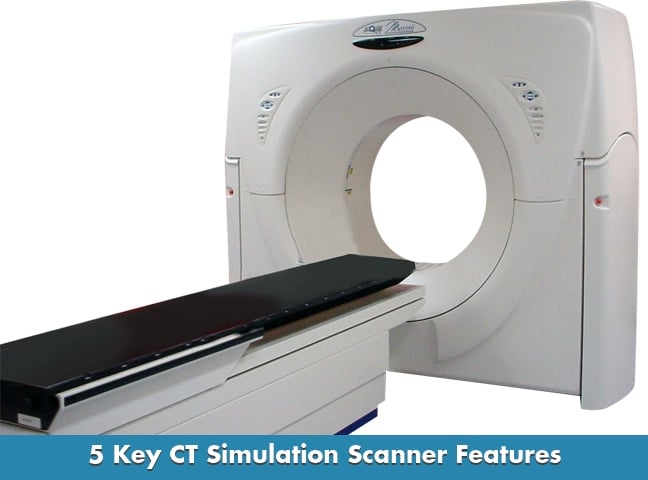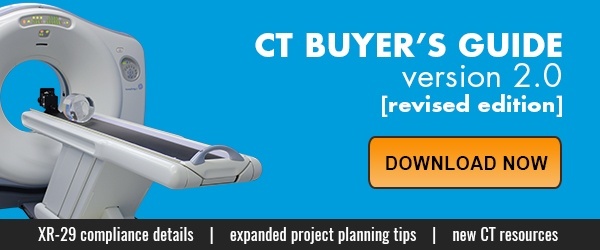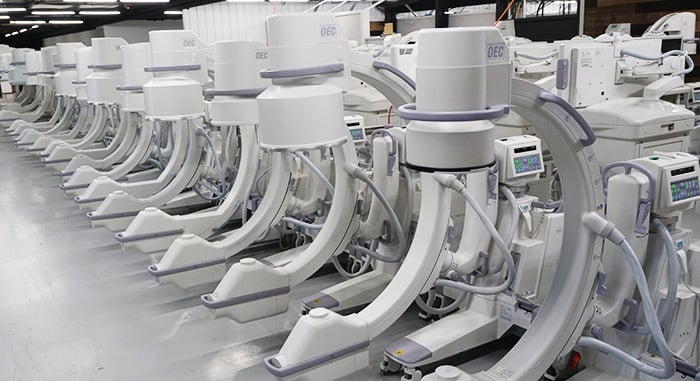
If your facility intends to provide patients with radiation oncology services, a CT scanner with CT simulation (CT sim) capabilities is a tool you'll need. These systems are used to create patient models that are the basis for radiation therapy treatments conducted on linear accelerators.
Not just any CT scanner can be used for CT sim, although all CT sim scanners can be used for general diagnostic scanning. So, this leads us to the question: Which features differentiate a CT simulation-enabled scanner from a standard CT scanner?
Larger Bore Size
According to the American Association of Physicists in Medicine (AAPM), "Conventional radiation therapy techniques often require patients to be in positions that can prevent them from entering the 70 cm bore opening found on the majority of CT scanners". Because of this, any scanner using CT sim to plan radiation therapy treatments should have a larger-than-conventional bore size.
Here are the bore sizes of several CT sim models from major manufacturers:
GE Lightspeed RT4 and RT16: 80 cm
Philips Brilliance 16 Big Bore: 85 cm
Siemens Open AS 20: 80 cm
Toshiba Aquilion LB 16: 90 cm
Flat Table Top
A CT sim unit also needs to have a flat table top. This feature eliminates differences between the tables of the CT sim scanner used for planning and the linear accelerator used for administering treatment. If precise patient positioning is not reproducible between the two systems, errors can occur.
External Lasers
While we're on the subject of patient positioning; a CT sim unit works best with external marking lasers. Patient marking can be done with lasers inside the CT bore, but as AAPM says, "these lasers can be difficult to use due to small aperture of scanner". Ideally, marking lasers should be mounted outside the CT gantry. This allows for greater flexibility and ease of use during the patient marking process.
HighTube MHU Capacity
Creating an accurate treatment plan requires a lot of images, which produces a lot of heat in a scanner's X-ray tube over a short amount of time. A system with a high tube heat capacity (expressed in millions of heat units or MHU) is needed to accommodate this. CT scanners designed for simulation use generally have tubes rated at 5 MHU or above.
Specialized Software Package
Scanners used for CT sim use different software than their general diagnostic counterparts. Along with a full-body volumetric image, AAPM tells us that the CT sim system, "provides virtual representations of the geometric capabilities of a treatment machine." Essentially, a model of the patient and a targeted treatment path are created by the software from the raw scan data.
The Cost Factor
With all these additional, specialized features, you've probably guessed that a CT sim system costs more that standard diagnostic CTs. If so, you are correct. Fortunately, there's good news on how you can remain budget-conscious while still stepping up your radiation oncology capabilities:
- The patient volume on a CT sim system is generally much lower than on a standard CT. Although the high-capacity tube is part of the cost, this is offset by the less frequent need to replace it.
- Because of their unique capabilities, having a CT sim scanner in your facility affords you the opportunity to be reimbursed for an additional range of HCPCS codes.
- CT sim systems are available on the refurbished market. A refurbished scanner is tested to the same standards of performance as new equipment, but costs significantly less.
If radiation treatment planning is a service you want to provide to your patients, we're here to help you get the tools you'll need to do that. Contact us to learn more about refurbished CT simulation equipment, parts, and service or continue reading in any of our free resources.
Note: As you consider a CT scanner purchase, make sure you're aware of NEMA standard XR-29!

Paul Crawford
Paul Crawford is the Vice President of Equipment Solutions at Block Imaging. Paul connects with healthcare facilities across the world to offer CT solutions and manages the wholesale sales team. When Paul is not helping customers with their CT needs, he enjoys spending time with his family, watching MSU sports, and CrossFit.






